Boxing matches between a human vs kangaroo are the stuff of legends in Australia and beyond. Sure, they were featured in cartoons, and stories of people engaging in these matches for entertainment or to save their pets have become popular in recent years. Nevertheless, it’s important to tell you right now that it’s not wise to try fighting any wild animal. After all, kangaroo boxing is a form of fighting behavior that can quickly turn fatal, even just between two animals.
What would happen if a human was foolish enough to take on a kangaroo? Would the mammal or the marsupial live if the human did not bring any weapons or tools to the fight? We’ll break it down for you, but just for the sake of clarity, do not try to box a kangaroo.
Comparing a Human and a Kangaroo
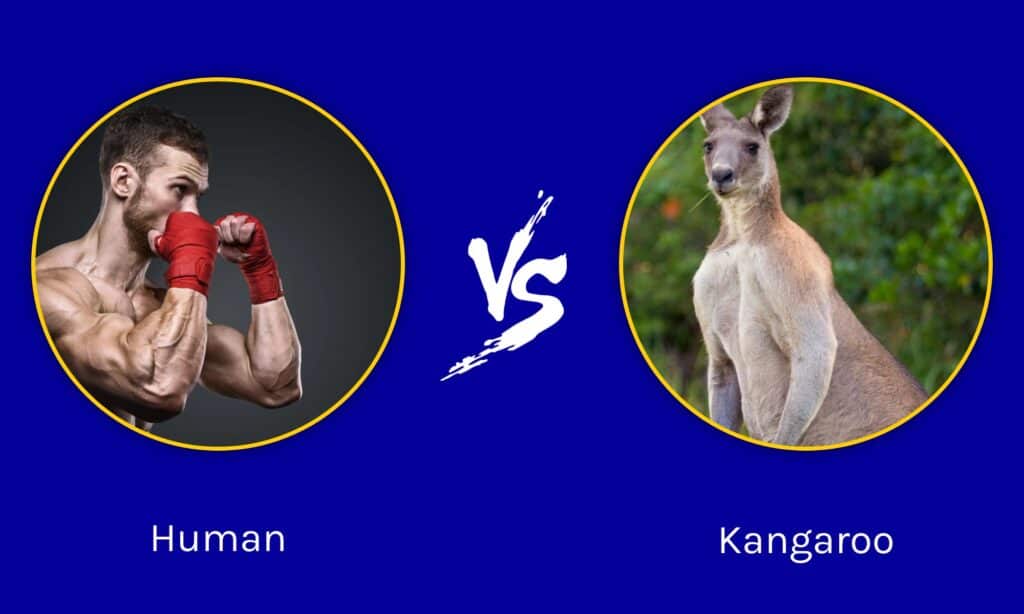
| Human | Kangaroo | |
|---|---|---|
| Size | Weight: 150-200lbs Height: 5.77ft (5ft 9in) | Weight: 100lbs-200lbs Height: 4.9ft-6.6ft tall |
| Speed and Movement Type | – 6-8 mph when running – Top speeds of 12-27mph | – 12 mph while hopping regularly – 35-44 mph maximum speed |
| Defenses | – Intelligence to avoid dangerous situations – Endurance – Ability to recognize ways to seek shelter and safety – Size compared to some animals | – Size will scare off some predators – Speed allows them to escape – Can lead animals to advantageous areas – Thick skin on stomachs to protect against attacks |
| Offensive Capabilities | – Can punch, strike, kick, and grapple – Relatively weak bite power and small teeth – Without tools, humans are limited in their offensive abilities | – Uses forelegs to grasp or strike enemies – Has claws on their forelegs – Uses the longest of the three claws on their hind legs to severely cut or disembowel enemies. |
| Predatory Behavior | – Cursorial predators that pursue and weaken prey with the aid of tools – Can trap and capture some prey | – Kangaroos are herbivorous, so they lack predatory instincts – They will still fight back when cornered by prey |
What Are Key Differences Between a Human and a Kangaroo?
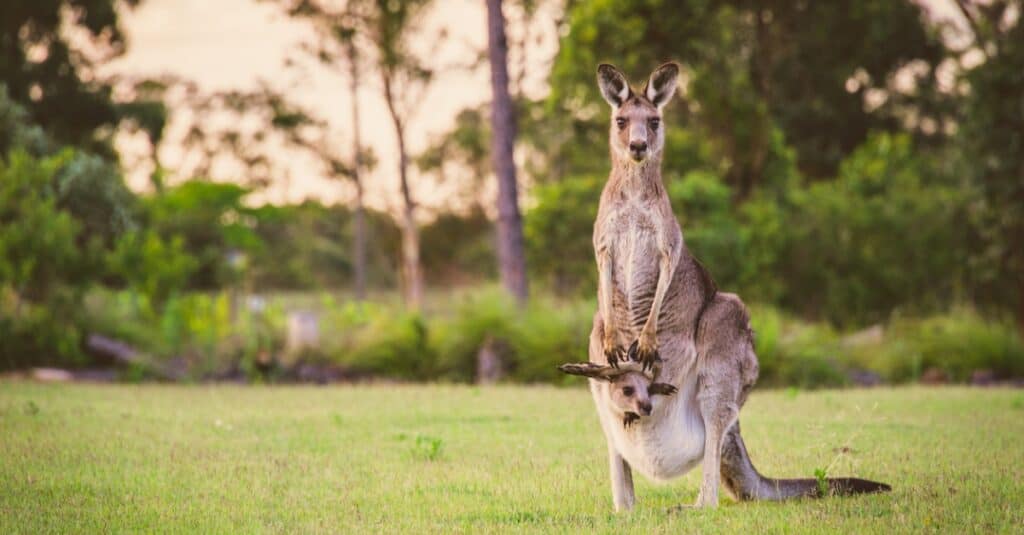
Kangaroos might seem like somewhat harmless creatures, but they can deliver severe attacks.
©iStock.com/Andrew Coleman
The key differences between humans and kangaroos include their morphology and intelligence. Human beings are highly intelligent bipedal mammals that walk as their primary form of locomotion and stand about 5.77ft tall and weigh upwards of 200lbs on average. However, kangaroos are bipedal marsupials with long tails that weigh up to 200lbs and stand 6.6ft tall, and hop as their primary form of locomotion.
These differences aren’t profound, but they help us understand what advantages one creature has over the other. We need to look closer at these animals and examine the factors that would decide the fight.
What Are the Key Factors in a Fight Between a Human and a Kangaroo?

Humans have tried to fight kangaroos on behalf of their pets to varying levels of success.
©iStock.com/Photoboyko
Since humans will not go into the fight armed, we need to look at matters beyond intelligence and tool use. This will be a battle between animals, so we must examine the size, speed, defenses, and other data to figure out which animal will win.
Human vs Kangaroo: Size
The average human and the average kangaroo are very similar in size. The overlap between these animals makes it hard to give either creature the advantage over the other. After all, the average human is between 5.2ft and 5.7ft tall and weighs between 150lbs and 200lbs. Of course, much larger humans exist.
Kangaroos can reach 200lbs and over 6ft in height, sizes that humans can attain, too.
We’re calling the size comparison a tie between humans and kangaroos.
Human vs Kangaroo: Speed and Movement
Kangaroos are much faster than human beings. The top speed of the average human being is between 12 mph and 20mph. However, the utmost human speed is 27 mph, a speed that one particular human couldn’t hold for more than a few seconds.
Kangaroos can move at 12 mph comfortably and reach speeds of 35-44 mph when trying to hurry.
Kangaroos have the speed advantage in this fight.
Human vs Kangaroo: Defenses
Humans have a hodge-podge of defenses outside of their intellectual endeavors. Without tools, humans rely on intelligence to avoid situations, endurance to get away from enemies, ingenuity to find shelter, and their size to ward off some attacks.
Kangaroos are tall, quick, great swimmers, and have thick skin on some parts of their body, like their stomachs, to prevent attacks.
Overall, humans have better defenses than kangaroos stemming from their intellect, but kangaroos have better physical defenses.
Human vs Kangaroo: Offensive Capabilities
Kangaroos can deliver a deadly attack from their legs. No, they don’t kick other animals to death. They disembowel them and rip them open with the long middle claw on their hind legs. Kangaroos will often strike or grapple an enemy and then balance on their tail to deliver a fatal blow.
Humans have relatively weak strikes, but they can use their feet, hands, and body weight to attack. In this particular case where we are prohibiting weapons to highlight human frailty, humans don’t have a particularly fatal attack to use in a fight.
Human vs Kangaroo: Predatory Behavior
Humans have several predatory abilities that allow them to trap and kill creatures. Aside from rudimentary ambushes without tools, humans are known for their cursorial hunting. They will use their endurance to track and attack prey once it is too weak to carry on. However, humans require tools to hunt many creatures.
Kangaroos are not predators since they are herbivores. However, they have some fighting instincts stemming from their boxing that serves as a competition for access to resources.
Humans have better predatory behaviors.
Who Would Win in a Fight Between a Human and a Kangaroo?
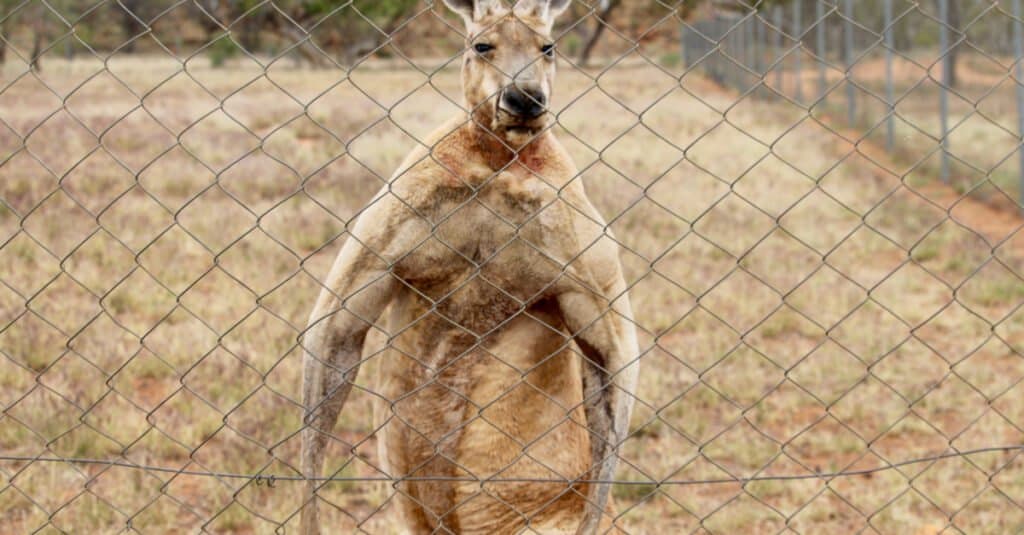
Kangaroos can be powerful and dangerous, especially against lone humans
©A Life Beneath Stars/Shutterstock.com
A kangaroo would win a fight against a human being. A human being might have a weight advantage or even a height advantage in extreme cases, but a kangaroo has deadly biological tools in the form of its claws that can easily kill humans.
Do not be fooled by videos of humans successfully attacking a kangaroo. In the wild, a kangaroo will try to grasp their prey and then tear into it with the claws on its feet.
This will inflict devastating wounds on a human being or even disembowel them. Without weapons and armor, humans are fragile to these wild animals.
Meanwhile, humans would have to attack the kangaroo’s head. Unless the kangaroo was small or the human was lucky, doing enough damage to the creature to kill it with one’s bare hands would be difficult.
Thus, the kangaroo secures the victory in this case.
What Animals Can Take Down a Kangaroo?
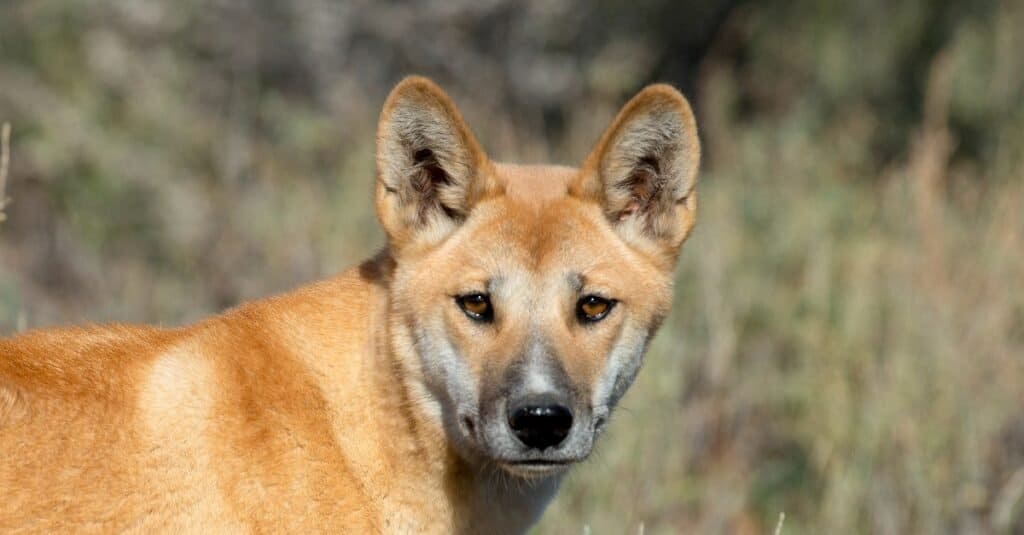
The dingo hunts in packs and has a preference for hunting larger prey
©John Carnemolla/Shutterstock.com
In a landscape seemingly devoid of large predators, it might just seem that the kangaroo reigns supreme. And it actually might. But for the presence of a thorny little problem: the dingo.
At a first glance, it looks like your average domestic canine. There’s that beautiful short coat in ginger and tan, that bushy fox-like tail, and those upright ears. And at 20 kg, it’s pretty similar to a medium-sized dog. Not very much to worry about.
Except that the mammal known as canis familiaris dingo, has a preference for meaty fare, and for pursuing larger prey. And they hunt in packs too. Just like wolves and African wild dogs, their distant relatives in Africa, the Americas, Asia, and Europe.
Bad news for kangaroos which have little hope of escaping an entire pack determined to run it down to exhaustion. And quite capable of seeing that intent through.
Bonus: Have Humans Ever Boxed Kangaroos for Sport?
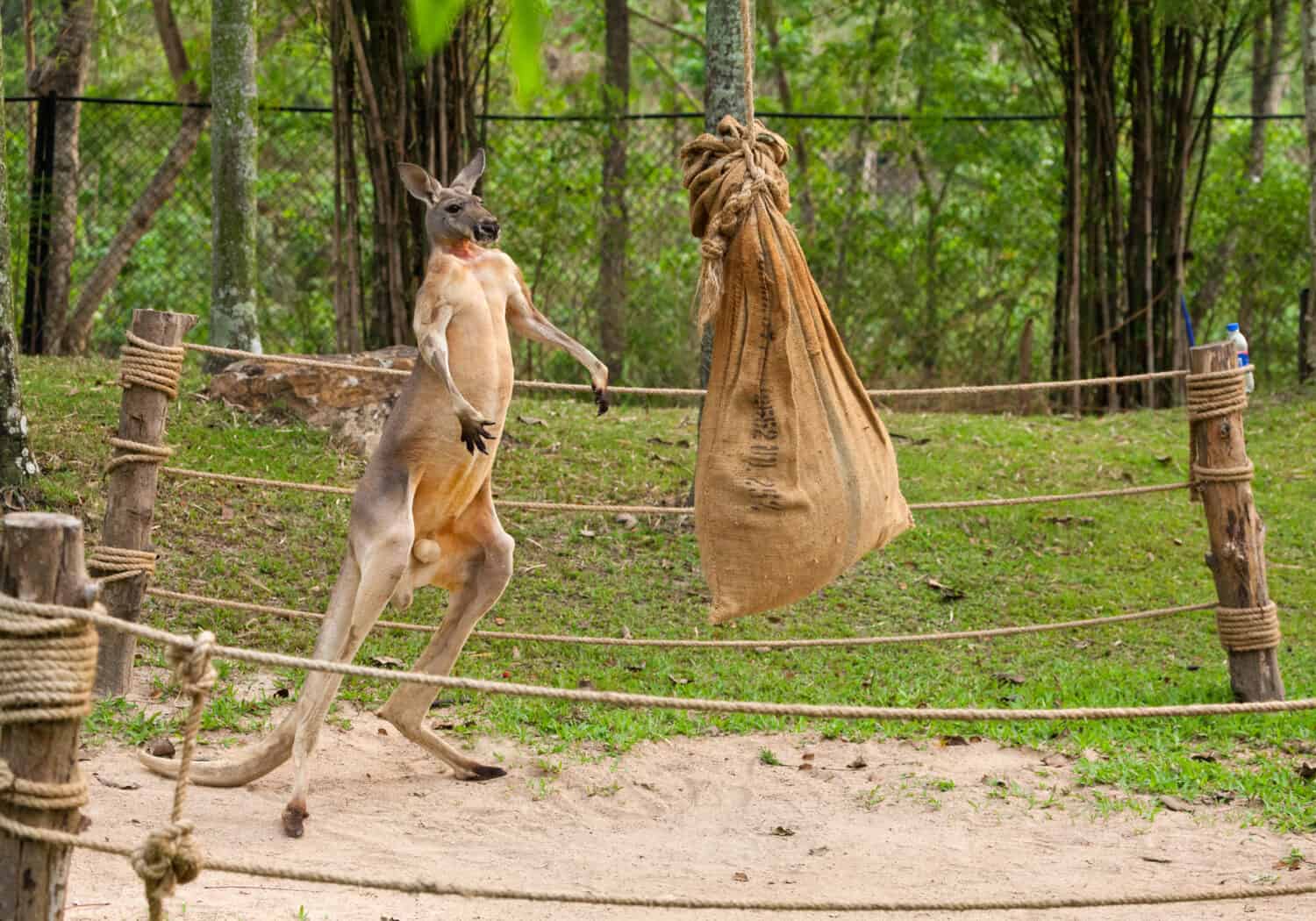
Kangaroos have been trained to box in the ring.
Image: apple2499, Shutterstock
©apple2499/Shutterstock.com
Boxing kangaroos have become a symbol of Australia but have these muscular creatures ever fought humans in the ring? Well, yes they have – but the sport didn’t last long. In the spring of 1891, kangaroo boxing occurred in Australia and the U.S. almost simultaneously. Australia’s star was Jack, who sparred daily with a man named Professor Linderman at the Melbourne Waxworks. Meanwhile, in the U.S., John L., a resident of the Philadelphia Zoo, sparred with his trainer after showing aptitude for the sport. It was said of both kangaroo boxers that they took to the sport easily – even “asking” for the training required – which included wearing boxing gloves.
Kangaroo boxing became a trend for a few years – often a feature at carnivals and exhibitions all over the world. As the kangaroos died they were replaced with Jack and John’s II. A kangaroo called “Big Frank” faced a boxer named Tom Tully at Madison Square Garden in June, 1893. The Germans even made a silent film about kangaroo boxing. The public actually grew tired of the “sport” by the early 1900s – although the practice didn’t die.
Fighting kangaroos have been depicted in countless animated shows and movies from The Flintstones to The Simpsons to Sailor Moon. Images of boxing kangaroos wearing gloves were painted on Australian planes and ships during World War II and the Australian Olympic Team still uses one as their mascot. There is probably a YouTube video of a guy boxing a kangaroo online right now.
The photo featured at the top of this post is © restyler/Shutterstock.com
Thank you for reading! Have some feedback for us? Contact the AZ Animals editorial team.






